Dark Matter, Northern Lights and Mars in 3D
Shedding light on the deepest depths of the universe is Professor Gerry Gilmore from Cambridge University, who talks about the Big Bang and the mystery of dark matter. We also hear from Professor Peter Muller and Dr Giulio del Zanna from the Mullard Space Laboratory about 3-D imaging of the surface of Mars and how solar flares contribute to everything from the Northern Lights to damaging communication systems. Professor David Block from the University of Witwatersrand describes how Andromeda, the galaxy closest to the Milky Way, was recently involved in a galactic collision, and in case you fancy seeing some collisions here on Earth, Derek and Dave are in the kitchen making meteorite craters.
In this episode
Bad News For Gorillas
Ebola is one of the worlds most virulent viruses and it may be wiping out the last few remaining mountain Gorillas. That's according to a study published this week by an international team of scientists lead by Magdalena Bermejo from the University of Barcelona, who studied the deaths of gorillas in west Africa following outbreaks of Ebola among humans. Repeated outbreaks of Ebola have occurred in West Africa where it is thought to have killed 1000 people since it was first recorded in 1976. Ebola causes massive internal and external bleeding, known as viral haemorrhagic fever and while Scientists are still working on a vaccine, there is currently no known cure for Ebola. Back in 2002 and 2003, there were several outbreaks of Ebola among humans in Gabon and the republic of Congo - and now researchers have confirmed that this was linked to a massive die-off of gorillas in a nature reserve in Congo, with an estimated five thousand gorillas killed - it is thought that ebola may already have killed a quarter of all gorillas in the world. Possibly the most worrying outcome of this study was the discovery that the gorillas appear to be transmitting the disease between each other at a much faster rate than in humans - so that together with commercial hunting for these magnificent animals, the increased threat of ebola could truly devastate the remaining populations of gorillas and could push them to extinction.
Hunting Fish Talk Team Tactics
Have any of you been watching on TV or over the internet the BBC's latest natural history documentary, Planet Earth? If you have, you might have seen the episode on shallow seas, in which dozens of swarming sea snakes went hunting with two other species of fish - an incredible cross-species phenomenon that was only very recently discovered on a remote island in Indonesia. Well, this week, another team of scientists have published a study revealing similar startling behaviour and cooperation between a different set of reef creatures - and not only do these guys hunt together, but they also talk about it too. The fishes in question, are moray eels - long thin slippery fish that hide among the gaps and crevices in coral reefs, and the large predatory groupers, who hang around and catch their prey in open water. These two have been seen hunting together before, with the eel chasing down prey inside the reef, and the groupers catching any fish that try to escape. But for the first time, Redouan Bshary and his team of scientists from the University of Neuchâtel in Switzerland, have seen the groupers communicating to the eels. While diving through the beautiful coral reefs of the Ras Mohammed National Park in Egypt, they noticed groupers were approaching moray eels and repeatedly nodding their heads from side to side - an invitation for eel and grouper to combine their hunting efforts. When the eel notices the nodding grouper, it immediately leaves its place in the reef and swims off with his new hunting partner. The team also noticed, that when a grouper chased a fish into the reef it would stand on its head and point in the right direction for the moray eel to slither in after it and dig out the prey.

- The Immune System: Part 1
The Immune System: Part 1
The definition of the immune system, which comes from the latin word immunis, meaning "exempt", is "a body's system (made up of many organs and cells) that protects the body from infection, disease 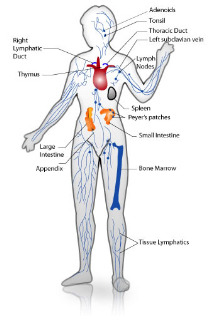 and foreign substances by producing an immune response."
and foreign substances by producing an immune response."
Scientists first began to examine the workings of the immune system - immunology - in the late 18th century when Edward Jenner introduced and studied the smallpox vaccine. However, evidence that our ancestors had some insight into the concept of immunity and disease can be traced back thousands of years, even as far back as early writings by primitive man.
For instance the four thousand year old Babylonian Epic of Gilgamesh, which tells of the exploits of a Mesopotamian hero, refers to pestilence and disease, whilst more recent writings from the dynasties of ancient Egypt also talk of disease. The Old Testament is likewise filled with references to pestilences that God wrought upon those who "crossed" him.
But in addition to describing the disease, these writings also reveal that ancient peoples were aware that once a person had been afflicted, if they survived, they were normally not able to contract that illness again. In other words, they were immune.
Later, in 430 B.C., Thucydides recorded that, while the plague was raging in Athens, the sick and dying would have received no attention had it not been for those individuals who had already contracted the disease and recovered and recognized their "immune" status. By about 1000 AD the Chinese were practising a form of immunisation by inhaling dried powders derived from the crusts of smallpox lesions and from the early 1400's the practice of pricking the smallpox powder into the skin became commonplace. This process was referred to as variolation and became quite common in the Middle East. Amongst patients who underwent the procedure, including royalty in some cases, the mortality due to smallpox fell to 1-2% from about 30%. But it was in 1798 that the real breakthrough came.
The vaccination breakthrough
A rural GP, Edward Jenner (below), had been fascinated by the claim that dairy maids, whilst frequently falling victim to cowpox, seemed to be invulnerable to smallpox. Reasoning that one might protect against the other he inoculated a young boy named James Phipps with material obtained from a cowpox lesion on the hand of a milkmaid called Sarah. She in turn had contracted the illness from her cow, Blossom.
 After a number of days, having escalated the dose of cowpox injected into his human guinea pig, Jenner exposed Phipps to smallpox. The boy was protected, and whilst the method wouldn't have been granted ethics approval today, Jenner had nevertheless made an incredible discovery. He dubbed the process vaccination, from the word vaccinia, the alternative name for cowpox.
After a number of days, having escalated the dose of cowpox injected into his human guinea pig, Jenner exposed Phipps to smallpox. The boy was protected, and whilst the method wouldn't have been granted ethics approval today, Jenner had nevertheless made an incredible discovery. He dubbed the process vaccination, from the word vaccinia, the alternative name for cowpox.
To further advance the emerging science of immunology required the development, by Louis Pasteur, of the "germ theory of disease". Pasteur's work was mainly concerned with the prevention of diseases caused by bacteria and how the human body was changed post-infection such that it was able to resist further insults. Consequently the 19th century saw the development of several vaccines against diseases such as cholera, rabies, diphtheria and tetanus. However, only relatively recently have advances in other areas of science provided the tools required for us to dissect out the molecular basis of how these vaccines work. Today, immunology is a broad branch of science covering the immune system of all species, its function and role in disease.
The vertebrate immune system is a collection of physical barriers, cells, proteins and chemicals that have evolved to protect an organism from a variety of pathogenic agents including bacteria, viruses, fungi, yeast and parasites. In order to function, a key property of the immune system is that it is able to distinguish these pathogens from an organism's own healthy cells and tissues.
So, in parallel with the evolution of these host defence mechanisms, microbes have evolved strategies to negate them, either by preventing an immune response or by counteracting host effector mechanisms. This continuous battle between the host immune system and microbial invaders has been fought throughout evolution and generally results in one of three outcomes: rapid elimination of the microbe, mortality of the host or chronic infection.
What are the basic components of the immune system?
The immune system protects the host from infection with layered defenses of increasing specificity. Immunity can be loosely divided into two categories, namely innate and adaptive. The more primitive of the two, innate immunity, has been described as the first line of defence against microbial invasion and acts in a relatively non-specific manner within hours of infection. Physical barriers such as skin and the lining of the lungs and gut are functional components of this system. They secrete fluids containing components that limit the risk of microbial invasion.
Despite these barriers some pathogenic microbes still gain access to tissues within the body. Thankfully, if this happens, there are other innate defenders waiting to welcome them. These incude systems that can chemically recognise microbes as foreign and either kill them directly or label them for subsequent elimination by specialised cells such as phagocytes, neutrophils or Natural Killer cells.
Although innate immunity is highly effective in its infection-preventing role, some pathogens have evolved mechanisms to circumvent these defences so the body has a second, more powerful, line of defence in place. This is adaptive (or acquired) immunity and it's unique to vertebrates. The system is antigen-specific meaning that it develops a long-lasting immunity to a particular pathogen by producing tailor-made antibodies and lymphocytes (T cells) that can recognise the invader.
This response develops over a period of days after primary infection, so it's not effective in preventing an initial invasion but it does come into play later. This is because the ability of the adaptive immune system to mount a highly targeted response to a particular pathogen is retained in the body long after the offending organism has been eliminated. This is known as immunological memory and it allows the immune system to mount fast and powerful attacks whenever the same pathogen is re-encountered.
Although we often think of it in isolation, the immune system is a complex set of organs and tissues including white blood cells, specialised molecules such as antibodies and complement, and a separate circulatory lymph system, which works with the cardiovascular system to move these defenders around the body to where they are needed. Organs of the immune system either make the cells that participate in the immune response, or act as sites for immune function. The key primary lymphoid organs of the immune system are:
o thymus
o bone marrow
The secondary lymphatic tissues include:
o spleen
o tonsils
o lymph vessels
o lymph nodes
o adenoids
o skin
When health conditions warrant, immune system organs can be surgically excised for examination while patients are still alive. Many components of the immune system are actually cellular in nature and not associated with any specific organ but rather are embedded or circulating in various tissues located throughout the body.
Clinical immunology is the study of diseases caused by disorders of the immune system. It also involves diseases of other systems, where immune reactions play a part in the pathology and clinical features. Diseases caused by disorders of the immune system fall into two broad categories: immunodeficiency, in which parts of the immune system fail to provide an adequate response (for example, chronic granulomatous disease), and autoimmunity, in which the immune system attacks self (for example, systemic lupus erythematosus, rheumatoid arthritis, Hashimoto's disease and myasthenia gravis). Other immune system disorders include different hypersensitivities, in which the system responds inappropriately to harmless compounds or responds too intensely (for example, asthma and hayfever). Clinical immunologists also study ways to prevent transplant rejection, in which the immune system attempts to destroy allografts.
In the next article we'll look more closely at scenarios in which the immune system fails and how this results in autoimmune conditions, like rheumatoid arthritis, thyroid disease and allergies, and what happens when some individuals are forced to cope without an immune system at all.
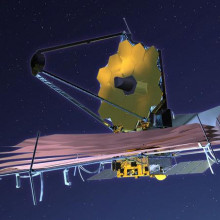
- Science Update - Stars, Planets and Space Telescopes
Science Update - Stars, Planets and Space Telescopes
with Chelsea Wald and Bob Hirshon, AAAS, the Science Society
Bob - This week for the Naked Scientists, Science Update goes to outer space. I'll talk about the telescope that's going to take over from the Hubble Space Telescope. But first, Chelsea tells us what scientists are learning about what stars and planets are made of.
Chelsea - Scientists have found a new ingredient in the increasingly strange and complex interstellar soup. It's a negatively charged molecule-meaning it's managed to hold onto an extra electron despite being assaulted by radiation that would tend to knock it off. Astrophysicist Patrick Thaddeus of the Harvard-Smithsonian Astrophysical Observatory says it's the first of its kind found in the large molecular clouds that percolate in space.
Patrick - These are the factories out of which stars are being made continuously in a galaxy like ours and presumably over the whole face of the universe.
Chelsea - They've already found the molecule in two clouds and expect to find it and possibly other negatively charged molecules elsewhere. Learning about this interstellar mix helps scientists know more about the ingredients that went into cooking up our Sun, the Earth, and ultimately, us.
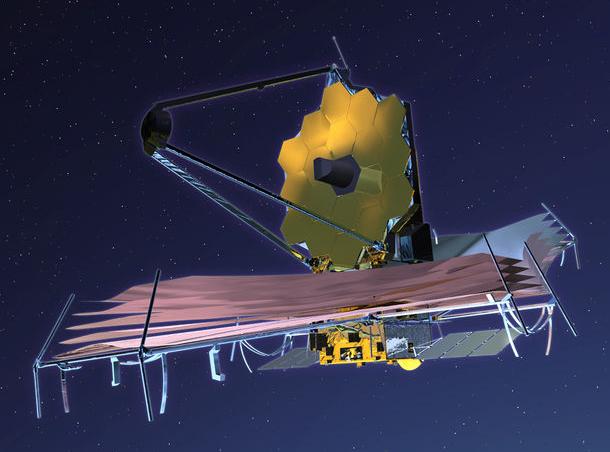 |
| The propsed James Webb Space Telescope to supercede the Hubble Space Telescope |
Bob - Thanks, Chelsea. NASA recently announced that it will service the Hubble Space Telescope one more time, meaning we'll have seven more years of its stunning images. But what comes after that? All eyes are on the James Webb Space Telescope, which will have a mirror seven times larger than Hubble's. It's designed to look at the youngest galaxies in the universe and see how planets form. Pam Sullivan, a manager for the telescope, says NASA engineers are already hard at work.
Pam - 2006 is actually the big year for us in that we're trying to demonstrate all of our technologies. We've got 10 what we call enabling technologies-things that we have to invent, basically, for the James Webb Space Telescope to work, and we're on track to finish up that this year.
Bob - If things go according to plan, the JWST will launch in 2013, just in time to take over from Hubble.
Chelsea - Thanks, Bob. We'll be back next week, when we'll grant people's Christmas wishes by answering some of their most pressing science questions. Until then, I'm Chelsea Wald.
Bob - And I'm Bob Hirshon, for AAAS, The Science Society. Back to you, Naked Scientists.

- Dark Matter And The Big Bang
Dark Matter And The Big Bang
with Professor Gerry Gilmore, University of Cambridge Institute of Astronomy
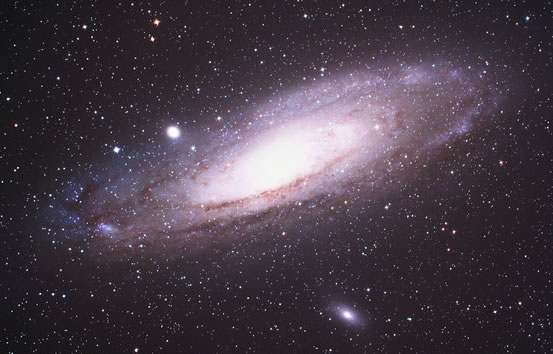
Chris - We're joined this evening by Gerry Gilmore who is the Deputy Director of the Institute of Astronomy at Cambridge University. Hi Gerry! Thank you for coming in.
Gerry - Hi Chris.
Chris - I have to say hello to everyone who's listening on radio Europe, REM FM. That means that one of the places we're being broadcast is the Canary Islands and that's a place where you do a lot of your observations because you have telescopes there, I gather.
Gerry - Yes that's right. The UK plus Spain and various other countries have really big observatories on top of the Canary Islands. They're nice dry sunny places.
Chris - Now Gerry, your interest is obviously in space science, but can we wind the clock back about 14 billion years ago to the time when the Universe was just beginning. Can you just sort of orientate us? What was the big bang? We all talk about it, but what actually was it?
Gerry - In a very real sense, it was the beginning. It's impossible to say what there was before, because there was nothing before the beginning. Our current understanding of the concepts is that one has just nothing. And nothing is a bit like the number zero. You can think of the number zero as being at the bottom of all the numbers and you count one, two, three off, for as far as you go. But it's also at the top of all the negative numbers, minus one, minus two, minus three and so on. And so having nothing, having zero, isn't actually the same as not having anything at all. When you have just vacuum, just energy, you actually have this really tense balance between all the positives and all the negatives. And occasionally, when you have that much tension pulling against itself, you get a little imbalance somewhere or another. And one of those little imbalances which just happen by chance, when it gets unbalanced enough, brings into something. And that something becomes the universe. And that something creates space, and it creates time. And so a universe, space and time, just flash into existence out of literally nothing.
Chris - Didn't people at one time say that studying space was anti-religion? They tried to argue that this was trying to de-cry the efforts of God, and Creation. I'm just saying that because Gilian in Wilburton said "is there any way to relate the big bang to God and Religion? Could we say that this is perhaps the moment of Creation?" Because we can literally put a time on when the Big Bang happened, can't we?
Gerry - Yes, a time that we know quite accurately, actually. We're able to measure it more and more accurately as the experiments get better. So, yes we know almost precisely when the universe first came into existence. You need to be a little bit careful to call that Creation, the word "Creation" is used slightly differently in physics than it is in some other subjects, and whether or not it's related to a cause, is of course one of the big questions of physics. And that's the fundamental distinction between a physics explanation for the universe and a religious explanation for the universe.
Chris - Now when you say you know exactly when it happened, how do we know exactly when the big bang happened? How can we put a time point on that?
Gerry - Well what we see today is the universe expanding, it's getting bigger and bigger all the time. And so we can just measure that speed of expansion directly, in fact we can measure it directly all the way back to the time when the universe was only about 270,000 years old. We have quite accurate measurements all the way back to then. And it's very easy then to extrapolate the last little bit, the last quarter of a million years, and so from that we can actually measure directly. Now that's because, there's a special thing about astronomy, it's totally unlike biology or any other subject. When we look out on the universe, because light is travelling at a finite speed, what we're actually doing is looking back in time. So when you look at the sun, you see the sun as it was seven or eight minutes ago, or whatever the number is. When you look out to stars that are light years away we see them as they were years ago. When we look back to the earliest galaxies, we see them as they were 10, 12 billion years ago. So the light left them, it's like a video picture coming through space towards us, that we just see today. And so in a real sense we don't know what those things are like now. But we do know precisely what they were like 12 or 13 billion years ago. So it's very easy for us to measure the past. It's just incredibly difficult to tell you about now.
Chris - So how do you know the universe is expanding? What are you watching to get those clues?
Gerry - All you need to do is measure a distance and distance is hard of course, but there are some objects whose brightness is known. And so we call them standard candles. They're particular types of star or exploding star, or types of galaxies or whatever. And when you see something that you know how bright it really is, and you measure how bright it seems to be to you, you can very easily work out how far away it is. It's just the old inverse square law. And so that's most of what cosmology is about. You measure things that you know how bright they really are, you measure how bright they seem to us and you work out how far away they are. And we measure their doppler shift. We measure how fast they're moving away from us. And so we see experimentally that as we look further and further away, things are moving faster and faster. And that is the definition of an expansion.
Chris - So what's actually driving the expansion? Obviously there was a big explosion for the big bang but something must be continuing 14 billion years later, to be pushing these things away. What's doing that?
Gerry - Well that is a non-trivial question actually. To start with, the universe just had enough energy from the bang. "Bang" was a term invented by Fred Hoyle here in Cambridge. It was a rather derogatory term but it turns out to be more accurate than he realised. It really was an explosion. And the energy of that explosion just threw space time out at a very high speed. It's slowly slowed down under it's own weight, which was pulling it back. And it in principle would keep slowing down and slowing down.
Chris - So is it growing at the speed of light? Or faster?
Gerry - That's another slightly non-trivial question. Yes, is the answer. The outer parts of the universe are always growing at the speed of light. But you need to be careful there because there's two sorts of universe. One is the universe that we can see. The observable universe, the stuff that we know about. And that is definitely growing at the speed of light. But there's also whatever else that might be out there that's beyond our horizons. And so one needs to be a little careful. People tend to confuse those two concepts, as do most of my colleagues I must say. And myself, quite frequently. But the universe is expanding. And the outer limits of it, the bits that we can observe, are expanding at the speed of light. But the local space time part is expanding much slower than that.
Chris - What's actually pushing it? What's making it do that?
Gerry - What it should be doing is just slowing down slowly. Inertia is just whatever's left over from the bang.
Chris - But you said it's speeding up.
Gerry - Yes that's right. It isn't doing that, which became apparent about 5 years ago. There was a hint a decade ago but it became clear only 5 years ago. And there was a very accurate determination of this only about 3 months ago. The universe is actually speeding up. We don't know what the physical cause of this is. What we know is the process. There is something that is sometimes called dark energy. It's a particularly unhelpful label, it's no more than a known unknown in the common sense of the term. But there is some intrinsic property of space time, which is it acts like a pressure. And it's pushing apart space-time itself. So it's not a force in the simple sense of the word, it's like a pressure.
Chris - I had heard though that if you just take that side of the equation, the equation would be rather unbalanced. The universe should be blowing itself to pieces so something is acting to negate that effect, again something we can't measure. Dark Matter. So what's that all about?
Gerry - Well dark matter only partially negates that effect. Based on the current numbers the universe is actually blowing itself apart. And it will continue to blow itself apart until eventually even something like the earth, or us, gets ripped apart by the expansion of the universe. And you end up with an entire universe containing nothing but one particle in it. So the universe will become a very lonely place. It really is blowing itself apart in a very ridiculous way. But, you're right. There's an awful lot of mass slowing it down and pulling against it. And in fact about 10 times more mass than you would guess from just looking at all the stars and galaxies and biologists in the world. And that matter, we know it's matter but it doesn't shine and so we call it dark matter.
Chris - Is there any way to find it? Is there any way to easily detect it? Presumably not or we would have found it by now.
Gerry - No, it's very easy to detect, actually. Matter has only one fundamental property, and that is that it knows about gravity. So matter both generates and responds to gravity. And that's the definition of matter. There are in fact three other forces in nature, which the sort of matter that we're made of respond to as well. But dark matter responds to probably none of those three. Certainly it doesn't respond to electromagnetic force which is what makes things shine, and therefore we call it dark. But it has matter and we can weigh it in fact. It's very easy to find.

- Mars in 3d
Mars in 3d
with Professor Peter Muller, Mullard Space Science Laboratory

Chris - It's been an exciting week for Mars this week. Let's join Peter Muller, who's from the Mullard Space Laboratory at University College London. Hi Peter! Thank you for joining us. Part of your work is to try to get a three dimensional map of the surface of Mars, and I have to say having seen it, I'm gobsmacked.
Peter - Well it has been a revolution. Over the last few years we've received this stereo data from the European Space Agency's stereo camera, and with that and new computer technology we've been able to find out what the true 3D shape of Mars is. And what we've learnt from this, is that water is playing an important part. And what we heard over the last week was that in fact over the last 10 years, it appears that water has acted on the surface. So all of that has only been possible because of the increased resolution that we have from the stereo camera, and our understanding of how water flows on other surfaces.
Chris - Peter can you just explain to us a bit about what the stereo camera is and how it works?
Peter - Well we have nine different views that look at different angles. So there's a short time interval between each of those different views.
Chris - Where are they looking from though?
Peter - They're looking from orbit. From a space craft that swoops down to about 250km above the surface. And then when it gets down to the lowest point, it starts sweeping out a swab over the surface, looking first forwards and then underneath and then looking backwards. And by finding common points between those three in just the same way that we find common points in our brains between objects that we see in our eyes, we get perception of depth.
Chris - So why are you doing this? I mean it sounds nice, having seen the pictures it was staggering, it was literally like being in an aeroplane flying over the surface of Mars, but what sort of benefits will there be for us in having this sort of information?
Peter - Well currently the most important scientific investigations of Mars are concerned with looking at conditions which might in the past or possibly even at the present time, where there's life. Now, in order for life as we understand it, to exist on another planetary surface, we have to have water. Now in the case of Mars we don't see any standing bodies of water, we see ice sheets, but we do see examples of how water has carved out the landscape. Now just looking at pictures, and working out that yes this looks like a feature such as a feature on the earth is one thing. But in order to prove that it's actually water, and also to be able to calculate how much water, we need to be able to work out what the true feature shape is. That's really the significance of this work. Now for the first time we can determine whether or not water has flowed on the surface and how much water was required, and when this water flowed.
Chris - So apart from studying the hydrodynamics of Mars, are there any other tangible benefits, sort of like finding sites to put bases of the future. President Bush wants to go to Mars doesn't he.
Peter - Yes, I mean in 20 to 30 years time it's likely that we will have humans. Although the passage to Mars is still a bit challenging in terms of radiation from the Sun. But in terms of finding likely spots, where we can put robots and of course in future, humans, is very dependent on knowing what the 3D shape of the surface is. Not just because we don't want to land one of these spacecraft on a rock-strewn, boulder-strewn landscape that the space craft is likely to break up and collapse. But also from the point of view that we need to know how the surface interacts with the atmosphere, and in the case of Mars, that can happen for up to 20kms above the surface. And that makes a huge difference as to where the balloons and the parachutes will actually land our space craft.
Chris - I presume it will also give us a good clue as to where hot spots would be for life if we were going to go looking. It should give us an idea as to where we should focus our attention shouldn't it?
Peter - Yes. So far not just the 3D but other instruments on the European Mars Express space craft are now on the American Mars reconaissance, are pointing to those most likely locations. And it's a source of great debate, both transatlantic and within Europe and within the US, as to where we should go, what is the most likely place. Now, each of us has our own favourite place on Mars, my favourite place on Mars is a place that we believe there was a large frozen sea of pack ice, that we saw about 18 months ago. And it was reported in the literature. We want to go there because we know that water flowed in that area in the last few million years which is very young. But of course, we've seen the observations last week of gullies, where there appears to have been water in the last 10 years. And they may also be places we want to target on future space missions.
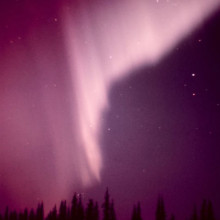
- Solar Flares And The Northern Lights
Solar Flares And The Northern Lights
with Dr Giulio del Zanna, Mullard Space Science Laboratory
Chris - Giulio is here also from the Mullard Space Since Laboratory. Hi Giulio, thank you for coming. Now you're not interested so much in Mars as the Sun. What are you doing with the Sun?
Giulio - Well I am interested in the Solar atmosphere. It's funny enough, I'm Italian, but I left Italy to study the sun here, so I left looking at the sun almost every day. The solar atmosphere in the last 10 years, since I've been here tends to SoHo so you can see all the atmosphere.
Chris - So using SoHo, what's the sort of mission aim? What are you trying to find out?
Giulio - Well basically we're trying to find out everything. The basics about the solar atmosphere. We still don't know the basics in terms of why it's so hot, the atmosphere. It's much hotter than the solar surface, we still don't know what the process is that accelerates the stream of particles that are coming out all the time from the sun and they reach the earth.
Chris - This is the solar wind? It's what a million mile an hour maelstrom of ionized material isn't it? It's a stream.
Giulio - Yes it goes streaming across and passing through the earth and throughout the whole solar system and creating all these wonderful displays of the auroras on the earth but also on all the planets.
Chris - So the northern lights and stuff is down to that?
Giulio - That's right, yes. The fast solar wind mostly. But then especially thanks to flares, when these big displays are happening, there's a link. For example when I was here I was able to predict a big explosion of the sun one day, and then it happened. And I was able to basically follow this huge energy release from the SoHo satellite. And we knew there were going to be huge Auroras, so it was very exciting one and a half days later.
Chris - Why do you actually get aurora borealis, the northern lights? What's actually happening to make them?
Giulio - Well what happens is there is this huge stream of particles that are coming together with huge masses of gas, about 10 thousand million tonnes or something like that, a huge amount of ionised gas that is streaming towards the earth. And then all these energetic particles they get trapped into the magnetosphere and then they follow basically the magnetic fields that we have on the earth. And so they stream down and they decelerate and interact with the upper atmosphere. They ionise our atmosphere, the oxygen and nitrogen atoms. And then they show the colours.
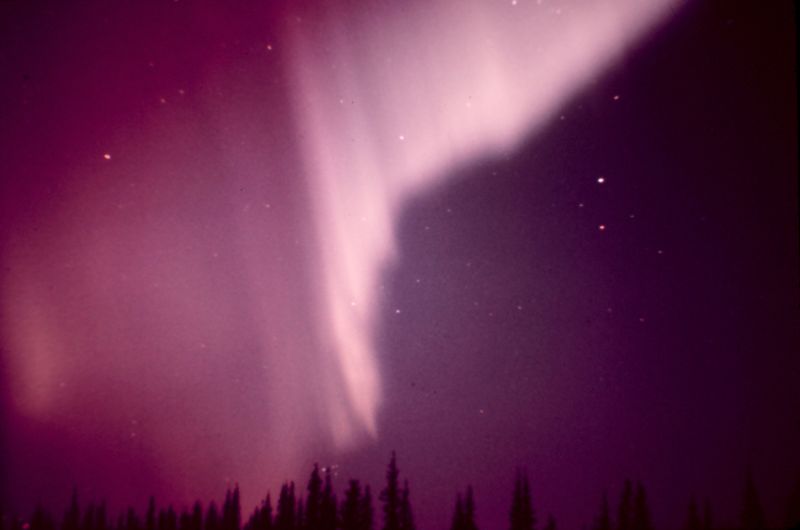 Helen - I've never seen the northern lights and I was wondering why we only see them at the north or south poles?
Helen - I've never seen the northern lights and I was wondering why we only see them at the north or south poles?
Giulio - It's because normally when the sun is quite normally active, that's where they are. You have these ovals which are very close to the North and South poles.
Chris - Just because that's where the magnetic field is dipping into the poles?
Giulio - Yes, that's right. When you have a flare, all that gets disrupted so you can get them to lower latitudes. You can see them even almost towards the equator in certain circumstances. I saw them even in Cambridge just because there was this flare that had this coronal mass ejection directed towards us. That was very nice. So they're easy to see actually, if you know when to see them and you have the right kind of combination.
Chris - I suppose one benefit of studying the behaviour of the sun is that it will enable you to know when communications on earth might be likely to be affected. Is that because satellites that we're using for our communications are also being bombarded by this radiation and this can cause problems?
Giulio - Yes, indeed. That has caused problems. To start with you have these energetic particles that come after just a few hours. You have first the light that comes in 8 minutes, and you have all these X-rays and you have all this very dangerous stuff, especially for humans in space who can get basically fried. But then you have after a few hours these very energetic particles, which can swamp all the detectors and cause damage. Plus you have after one day or something, you have these bubbles of gas passing at high speeds. And they've been known to cause trouble for even shut down satellites. The last one was in 1997, in the past there have been a lot of cases of this, they can shut down satellites and cause trouble. And of course the other problem is that all these X-rays they deform our ionosphere. They deregulate all of our upper atmosphere so when they happen basically they can affect all the transmissions, their upper frequencies, they can change a lot of things.

- Ripples in Andromeda
Ripples in Andromeda
with Professor David Block, University of Witwatersrand, South Africa
Chris - In October, scientists spotted something pretty unusual in our cosmic neighbourhood. Using the Spitzer space telescope, David Block and his team have spotted a collision between the nearby Andromeda galaxy and a smaller companion galaxy and what's really exciting is that, relatively speaking, it's only just happened.
David - What we are actually reporting in Nature is something quite extraordinary, a head-on collision of one galaxy plunging through the actual disk of the Andromeda spiral. This is quite extraordinary. Normally these sorts of collisions are reserved for galaxies in our very distant Universe but, to find a head-on collision right on our doorstep, is truly riveting.
Chris - Is this something that's happened fairly recently then in cosmological time?
David - I think that this is what makes the research additionally so incredibly exciting, is that yes, dinosaurs roamed on Earth when this head-on collision actually took place. We estimate that the collision took place only 200 million years ago which, in cosmological context, is extraordinarily short.
Chris - How did you actually spot it though, David?
David - The rings were spotted using the Spitzer Space Telescope and what is very interesting is Andromeda has a very large bright pregnant bulge of stars. And these stars absolutely would masquerade any rings in the optical wavelength regime. But of course we must remember, using the Spitzer Space Telescope, we start receiving photons of lights in the near and in the mid infrared regime. And what the Spitzer images revealed were two rings, an outer ring of diameter of approximately 65,000 light years, and an inner ring. Now it's this inner ring which is totally new, which has never been really reported before. The inner ring has a dimension of around 5,000 by 3,000 light years. And the set of two rings are indeed the smoking gun evidence for a head - on collision. Perhaps if I could explain by means of an analogy. If you take a stone and you throw it into a pond of water it creates a ripple effect. And what they've gone and discovered: my team has actually found all these sets of rings point to a very violent past in our closest spiral galaxy.
Chris - How do you know it only happened 210 million years ago?
David - What has been very interesting is – and we've been very privileged to work at the Observatoire de Paris in France – and using some of France's most sophisticated computers, they've actually been able to simulate the collision. And what the simulations beautifully prove is that, if you set everything up correctly in order to get the companion galaxy to where it is today, you have to backtrack by only 200 million years for this violent head-on collision to have taken place. And so it's using very sophisticated computer codes that doctors Bournaud and Combes have actually been able to show, that this amazing collision has taken place very, very recently.
Chris - David Block from the University of Witwatersrand in South Africa who's found evidence for a headlong collision between our neighbour, the Andromeda galaxy, and a companion galaxy that formed alongside it.

- What percentage of my brain is being used?
What percentage of my brain is being used?
I would say all of it in one way or another, although there will be some areas which will be more active than others. There's an old urban myth that you only use 10% of your brain. It's absolute rubbish as the brain has such a high metabolic rate. In fact, the part of the brain that has the highest metabolic rate and burns off more energy than any other part is in fact your retina. It's part of the brain itself because it's an extension of the central nervous system. If you look at someone who's had a stroke and damaged a bit of their brain, even though they might be doing a task that doesn't directly seem to involve that part of the brain, the person still doesn't seem to be completely right. They still obviously have some difficulties. So we know that all of the brain is used probably all the time but some bits are recruited and do slightly more some of the time. And the reason we know that is because you can inject substances into people which are used as a way to map out which bits of the brain are more active than others. So you give people a radioactively labelled glucose molecule for example, because the brain loves glucose. Wherever the brain is doing more work, it needs more energy, so it burns more glucose. So in a special scanner, you can see where the radioactivity is being concentrated. That's called a PET scan, and it tells you which bits of the brain are doing what jobs. Because you can get people doing repetitive tasks, if you ask them to just move their right hand for example, and the part of the brain that's concerned with just moving the right hand will light up.

- Can you buy Polonium 210?
Can you buy Polonium 210?
Despite this, it is still difficult to obtain. See http://www.unitednuclear.com/isotopes.htm for a full explanation. Basically, you'd need to spend millions on thousands of units, and then purify it all, before coming up with a decent amount. Frankly, its be easier to do same with americium from smoke alarms … Aside from the brushes, most polonium used in devices is electroplated on to a metal base – and that like saying that silver-coated steel forks are a good source of silver. They're not, because you have to melt the stuff down and go through a complicated separation procedure to get it away from the steel once its been electroplated.

The big bang theory... what went bang?
That's a good question. Well the answer strangely enough is nothing. And that's the key. This point I mentioned briefly before about zero. If you think of nothing, nothing is actually a big balance between a big positive and a big negative. And if occasionally that little balance goes wrong, you go from nothing to something, very quickly indeed, and you get an awful lot of something in a very small place. And so in a very real sense of the word, the big bang sprang out of nothing.
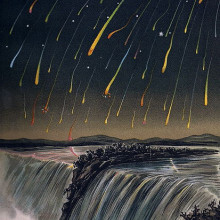










Comments
Add a comment